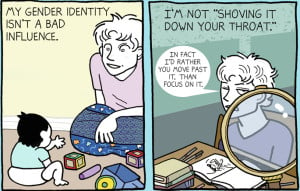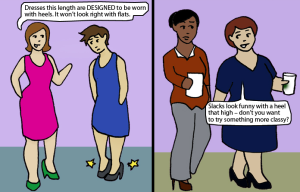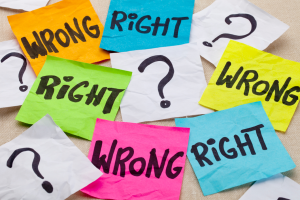
EF
I’ve let my hair grow out so long that I have to put it in pigtails when I ride my bike so it doesn’t get caught in my helmet straps. I’m wearing my girlfriend’s tiny turquoise athletic shorts. My legs are closely shaved, and I’m sitting curled up on the couch with a game of Candy Crush on my phone to my right and a sleeping cat to my left.
I sound like a girl, right?
I’m not.
Why? Because I don’t identify as one.
And although it really is as simple as that, I understand where some people have trouble: “If you express yourself in this way,” they wonder, “then doesn’t that imply that that is how you identify?”
But the truth is, well, no.
Although gender identity and gender expression can be related, the point is that they don’t have to be.
So what’s the difference?
Gender Identity vs Gender Expression
Gender identity is internal.
It is, quite simply, the gender with which you identify. It’s the word (or words) that you could use to decide yourself that simply make sense to you.
Gender identity is whether you’re the lady or the tramp (or neither). It’s the all-encompassing feelings you have about which gender(s) you are or are not. It’s what you would be perceived as if you were able to choose how everyone perceived you.
Gender identity is internal, deeply-rooted, and a central part of many people’s senses of self.
For example, I identify as masculine-of-center. If I were to say “I am a woman,” it would feel as ridiculous as if I were saying “I am a dinosaur.”
Gender expression, on the other hand, is what everyone around us can see.
Gender expression is the way in which you express your gender.
Sometimes these expressions go along with socially sanctioned ideas of what is appropriate. For example, we live in a society that deems dresses appropriate for women, but not for men. But sometimes they don’t.
You may identify as a woman and dress in a traditionally feminine way. You may identify as a woman and dress in a traditionally masculine way. The point is that the two aren’t necessarily related.
The way that someone expresses their gender is not necessarily a clue as to how they identify their gender.
Misgendering
Many people never get challenged on their gender identity.
We see a curvy person with long hair in a dress, and when she says her name is Mary and uses female pronouns to refer to herself, we don’t bat an eye.
But some people, usually trans people, get their gender identities questioned all the time.
Every single time I call Car2Go user support, for example, they ask me if “Wiley is in the car with me.”
Y’all, there is a note in my file that I am trans and that my voice is high because I got so tired of being asked to verify my drivers’ license number (which is not standard operating procedure, when, say, you’re calling to report that someone’s left their umbrella in the car).
Still, people are so programmed that high voices only belong to women that when they hear my voice, they assume I am not the person I say I am. As you can imagine, this is frustrating on a good day and awful on a bad one.
Have you ever had a co-worker get your name slightly wrong? Like your name is Francine and they keep calling you Francesca? And you didn’t correct them at first and now you feel like you can’t, but it pisses you off every single time it happens? Like, seriously I’ve worked with you for four months, learn my damn name?
Have you ever had a family member who aggressively teases you for doing something “cross-gender” like the mom in Bend it Like Beckham who thinks her daughter can’t get a boyfriend because she loves soccer too much?
Being trans, especially if all your gender markers don’t quite line up (like if you’re a man with long hair and breasts or a 6’4” woman with a five o’ clock shadow), is like the situations I mentioned above only multiplied by a factor of a gajillion.
People are constantly telling you what you look like is wrong, how you think of yourself is wrong, the pronouns you use are wrong, even the name you go by is wrong. It is an inundation of patronizing comments that all mean “I know you better than you know yourself.”
Trans and genderqueer people are as complex and varied in their gender expression as non-trans people.
We’d never tell Angelina Jolie that she’s not a woman because she shaved her head or Hugh Jackman that he’s not a man because he owns a tiny coat-wearing dog. So why do we police trans people’s identities based on their aesthetic choices or the way their bodies look?
I’m taller than Danny DeVito – does that make him less of a man than me?
Gender as a Constellation
Even if you are not transgender, chances are there’s something about you (or lots of things about you) that don’t fit perfectly into a pre-destined gender mold.
That’s the beauty of being human – that when a baby is born, we have no idea whether it will like chocolate, or sing beautifully, or become a champion boxer.
We tend to think of as gender as a fixed quality, but really it’s more of a constellation of traits.
Think about the men you know. Does each one love cars? Do they all have beards? Probably not – unless you’re from a NASCAR family of course.
Each man has a constellation of gender characteristics that together add up to “man.”
Trans people also have gender constellations – a whole cloud of characteristics related to their gender.
The ratios of traditionally masculine to traditionally feminine qualities may be different than you’re used to, but that does not make a trans person’s gender any less real or valid.
Trans people might appear to have a more confusing gender than you or most of the people you know, but in reality we are all just a sum of our likes, dislikes, values, and habits. We’re all a delightful mish-mosh of weirdly specific qualities.
***
If you are genuinely confused when presented with someone who has an unusual set of gendered characteristics and you’re not sure what to do or how to interact with them, just ask them.
Use general rules of engagement. If you don’t know them, grilling them on their gender is likely not a good idea, but many trans people will be delighted to answer your questions, so long as they are posed respectfully.
They will tell you what pronouns they use, and any other information they feel is relevant or useful, and then you can interact with them just as you would anyone else – by bonding over shared interest or politely ignoring each other (if you’re me – or a New Yorker).
It’s pretty normal to be shocked, or surprised, or even uncomfortable when you come across someone breaking gender barriers.
We’re all socialized to think of gender as a fixed, unchanging, biologically imparted quality.
But a little critical thinking reveals that this is a falsehood, and a little open mindedness gives you access to a world of freedom with regards to gender.
Gender “creativity” is getting less and less stigmatized, so there’s more art and fashion and media than ever that showcases people with non-traditional gender presentations. Check it out!
And if it feels right to you, experiment with your own gender presentation.
Iggy Pop likes the occasional frock — maybe you will, too!
[do_widget id=”text-101″]
Wiley Reading is a Contributing Writer at Everyday Feminism. Wiley is a New Jersey-born artist, writer, environmentalist, and social justice advocate located in Burlington, VT. He works as a community health worker for the Greater Burlington YMCA, and writes for Disrupting Dinner Parties, a small collective feminist blog. In his free time, Wiley draws bugs and old buildings, loves every show on the Food Network, makes creative (read: pulled from the recycling) toys for his bunnies, and tipsily reminds every person in every bar that New Jersey is the best state. Follow him on Twitter @wreadinggo.
Search our 3000+ articles!
Read our articles about:
Our online racial justice training
Used by hundreds of universities, non-profits, and businesses.
Click to learn more




















